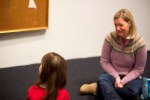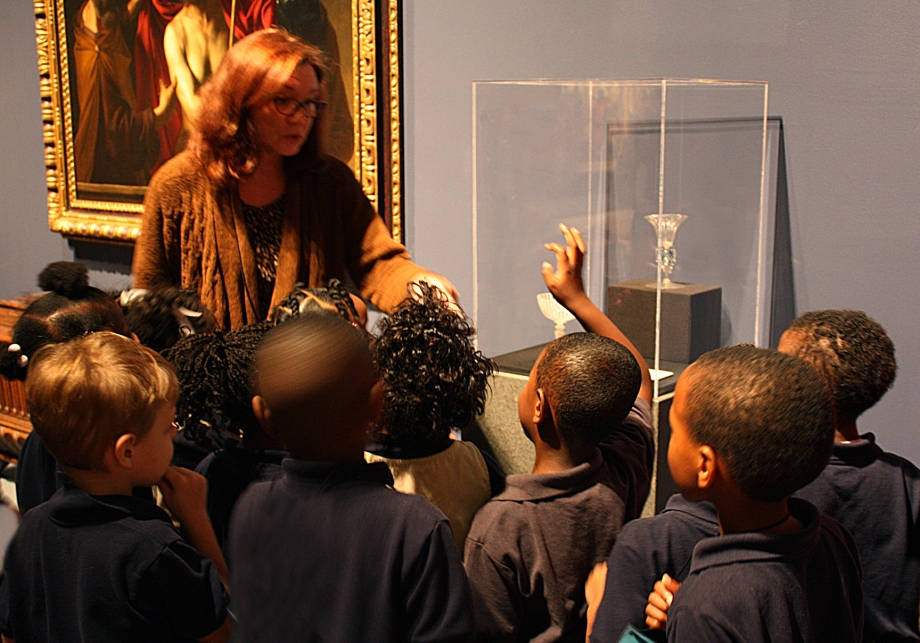This weeks’ teacher feature shows how one of SEEC’s two-year-old classes were inspired by Oscar de la Renta’s Ikats in the To Dye For: Ikats from Central Asia exhibition at the Freer|Sackler Galleries. Educators Brittany Leavitt, Brittany Brown, and Melinda Bernsdorf used these iconic ikats to facilitate a learning experience that focused on the colors, patterns, and symmetry that can be seen in both butterfly wings and these dyed fabrics. Below you will find images from the lesson as well as reflections from the educators.

Preparation:
 At SEEC, our faculty uses an emergent curriculum, which means they follow the interests of the children to create units and lesson plans. They were able to connect the class’s interest in various topics including eggs, frogs, and bugs by exploring the life cycle of the butterfly.
At SEEC, our faculty uses an emergent curriculum, which means they follow the interests of the children to create units and lesson plans. They were able to connect the class’s interest in various topics including eggs, frogs, and bugs by exploring the life cycle of the butterfly.
We were inspired to teach this lesson because of our class’s interest in the metamorphosis of frogs and other things that grow from eggs. Additionally, our class was really into finding insects including worms and potato bugs on the playground. We decided to explore their interest more by getting a butterfly kit for the classroom.

Brittany Leavitt began the day by gathering the group and led the class in a discussion about the butterfly. She began by reviewing previous topics on butterflies, including the number of wings butterflies have, and by reading Waiting for Wings by Lois Elhert.
After our metamorphosis unit, I decided to spend a week on exploring butterflies. Butterflies can be such a big topic so I wanted to narrow in on just one focus: the wings of a butterfly. We started by breaking down and labeling the parts of the butterfly. Then we started focusing on the butterfly wings. In particular, I wanted my class to understand butterfly wings are a multifaceted tool which are used for both protection and transportation. I also wanted to introduce the idea of symmetry with the wings.
Lesson Implementation:
 The class’s museum visit began on their walk to the Freer|Sackler Galleries. They were able to weave this walk into their lesson as the class tried to spy butterflies.
The class’s museum visit began on their walk to the Freer|Sackler Galleries. They were able to weave this walk into their lesson as the class tried to spy butterflies.
As we walked over to the Freer|Sackler Galleries, I had my class turn on their “spy eyes” to look for butterflies in the gardens. We had the chance to observe a butterfly on a flower. While looking at it, we revisited the topic of butterfly wings and talked about the butterfly’s bright colors and camouflage.
Anytime they spotted a butterfly on a flower or in the air, I would ask, “What do you think the butterfly is doing?” or “Where do you think it’s traveling?” These are great, simple questions that help to start a conversation. I was sure to ask questions that prompted critical thinking and creativity without being overwhelming for the two and three-year-olds in my class. In general, this walk was a great way to refresh the key words and topics we were going over throughout the week.
 The class gathered around the Oscar de la Renta designs. The class looked closely at the textiles and discussed the colors and patterns that they saw.
The class gathered around the Oscar de la Renta designs. The class looked closely at the textiles and discussed the colors and patterns that they saw.
I chose to visit the Ikats from Central Asia because of its parallels to the symmetry, color, and patterns of the butterfly wing. When we entered the gallery, we took a few minutes for each child to look closely at the ikats. Then we began describing the ikats with words. As the class described the ikats, I noted that the pattern on some ikats was symmetrical. The class worked together to define symmetrical and then related it to butterfly wings. We concluded our time in the gallery by singing the fingerplay song “Butterflies”.

After visiting the galleries, the class went outside to the Haupt Garden and continued to explore butterfly wings. Brittany handed out paper butterflies that the class had previously created so they could continue to observe the symmetry of the butterfly wings.
I brought butterflies that the class made earlier in the week and continued our discussion on symmetry. We did a three step process to help us further understand symmetry. First we looked at our butterfly creations as a whole. Then we folded the butterfly wings like we were closing a book. We followed this up by observing how both sides of the wings look the same.
Reflection:
 The class loved being outside and singing about butterfly wings. They were able to play with and further explore butterflies that they previously created.
The class loved being outside and singing about butterfly wings. They were able to play with and further explore butterflies that they previously created.
To extend this in the classroom, we played a simple symmetry puzzle that I created by printing off large pictures of butterflies and cutting them in half. We also used paint to create our own butterfly patterns.
 On the walk back, the class went through the Pollinator Garden. As they walked the teachers engaged the class in casual conversations about which plants the butterflies might prefer.
On the walk back, the class went through the Pollinator Garden. As they walked the teachers engaged the class in casual conversations about which plants the butterflies might prefer.
For teachers who want to try out this lesson, I recommend creating a small pollinator garden if you have space in your outdoor area. You can buy butterfly kits online. They are a great way to watch the stages in the classroom. You can later on do a special butterfly release.
Teaching this lesson was a great way as teacher to challenge myself to dig deeper into a new topic. I love watching my class become interested in a topic. When presented in a developmentally appropriate way, young children are able to explore and understand incredibly complex topics. For example, my class was able to understand the concepts of symmetry and metamorphosis. They particularly loved the word metamorphosis and would say it frequently with the correct meaning. When I heard them say metamorphosis, it let me know that this topic of butterflies really stuck with them and impacted their view of the world.

















 yet, I find myself in the position of having to provide and support art based projects. I am not going to lie, I have often felt a little out of my element and concerned about creating authentic art experiences. And I’m guessing I’m not the only one. I am certain there are other early childhood educators and parents out there who dread the “art activity” largely because many of us have the mindset of either being good or bad artists.
yet, I find myself in the position of having to provide and support art based projects. I am not going to lie, I have often felt a little out of my element and concerned about creating authentic art experiences. And I’m guessing I’m not the only one. I am certain there are other early childhood educators and parents out there who dread the “art activity” largely because many of us have the mindset of either being good or bad artists.


























